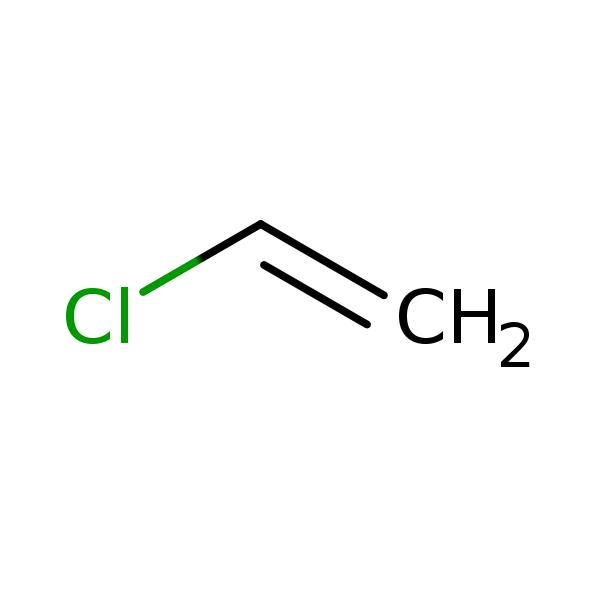Vinyl chloride
CASRN 75-01-4 | DTXSID8021434
- Toxicological Review (PDF) (197 pp, 1.2 M)
- IRIS Summary (PDF) (64 pp, 341 K)
Noncancer Assessment
Reference Dose for Oral Exposure (RfD) (PDF)
(64 pp, 341 K)
Last Updated: 08/07/2000
| System | RfD (mg/kg-day) | Basis | PoD | Composite UF | Confidence |
|---|---|---|---|---|---|
| Hepatic | 3 x 10 -3 | Liver cell polymorphism |
NOAEL
(HED):
9
x 10-2 mg/kg-day |
30 | Medium |
Reference Concentration for Inhalation Exposure (RfC) (PDF)
(64 pp, 341 K)
Last Updated: 08/07/2000
| System | RfC (mg/m3) | Basis | PoD | Composite UF | Confidence |
|---|---|---|---|---|---|
| Hepatic | 1 x 10 -1 | Liver cell polymorphism |
NOAEL
(HEC):
2.5
mg/m3 |
30 | Medium |
Cancer Assessment
Weight of Evidence for Cancer (PDF)
(64 pp, 341 K)
Last Updated: 08/07/2000
| WOE Characterization | Framework for WOE Characterization |
|---|---|
| A (Human carcinogen) | Guidelines for Carcinogen Risk Assessment (U.S. EPA, 1986) |
| Known/likely human carcinogen | Proposed Guidelines for Carcinogen Risk Assessment (U.S. EPA, 1996) |
- On the basis of sufficient evidence for carcinogenicity in human epidemiology studies, VC is considered to best fit the weight-of-evidence Category "A," according to current EPA Risk Assessment Guidelines (U.S. EPA, 1986). Under the Proposed Guidelines for Carcinogen Risk Assessment (U.S. EPA, 1996), it is concluded that VC is a known human carcinogen by the inhalation route of exposure, based on human epidemiological data, and by analogy the oral route because of positive animal bioassay data as well as pharmacokinetic data allowing dose extrapolation across routes. VC is also considered highly likely to be carcinogenic by the dermal route because it is well absorbed and acts systemically.
- This may be a synopsis of the full weight-of-evidence narrative.
Quantitative Estimate of Carcinogenic Risk from Oral Exposure (PDF) (64 pp, 341 K)
Oral Slope Factor:
7.2
x 10-1
per mg/kg-day
(Continuous lifetime exposure during adulthood)
Drinking Water Unit Risk:
2.1
x 10-5
per µg/L
x 10 (Continuous lifetime exposure during adulthood)
Extrapolation Method: LMS method
Tumor site(s): Hepatic
Tumor type(s): Total of liver angiosarcoma, hepatocellular carcinoma, and neoplastic nodules (Feron et al., 1981)
Oral Slope Factor:
7.5
x 10-1
per mg/kg-day
(Continuous lifetime exposure during adulthood)
Drinking Water Unit Risk:
2.1
x 10-5
per µg/L
x 10 (Continuous lifetime exposure during adulthood)
Extrapolation Method: LED 10/ linear method
Tumor site(s): Hepatic
Tumor type(s): Total of liver angiosarcoma, hepatocellular carcinoma, and neoplastic nodules (Feron et al., 1981)
Oral Slope Factor:
1.4
per mg/kg-day
(Continuous lifetime exposure from birth)
Drinking Water Unit Risk:
4.2
x 10-5
per µg/L
x 10 (Continuous lifetime exposure from birth)
Extrapolation Method: LMS method
Tumor site(s): Hepatic
Tumor type(s): Total of liver angiosarcoma, hepatocellular carcinoma, and neoplastic nodules (Feron et al., 1981)
Oral Slope Factor:
1.5
per mg/kg-day
(Continuous lifetime exposure from birth)
Drinking Water Unit Risk:
4.2
x 10-5
per µg/L
x 10 (Continuous lifetime exposure from birth)
Extrapolation Method: LED 10/ linear method
Tumor site(s): Hepatic
Tumor type(s): Total of liver angiosarcoma, hepatocellular carcinoma, and neoplastic nodules (Feron et al., 1981)
Quantitative Estimate of Carcinogenic Risk from Inhalation Exposure (PDF) (64 pp, 341 K)
Inhalation Unit Risk:
4.4
x 10-6
per µg/m3
(Continuous lifetime exposure during adulthood)
Extrapolation Method: LMS method
Tumor site(s): Hepatic
Tumor type(s): Liver angiosarcomas, angiomas, hepatomas, and neoplastic nodules (Maltoni et al. (1981, 1984))
Inhalation Unit Risk:
8.8
x 10-6
per µg/m3
(Continuous lifetime exposure from birth)
Extrapolation Method: LMS method
Tumor site(s): Hepatic
Tumor type(s): Liver angiosarcomas, angiomas, hepatomas, and neoplastic nodules (Maltoni et al. (1981, 1984))
Inhalation Unit Risk:
4.4
x 10-6
per µg/m3
(Continuous lifetime exposure during adulthood)
Extrapolation Method: LED 10/ linear method
Tumor site(s): Hepatic
Tumor type(s): Liver angiosarcomas, angiomas, hepatomas, and neoplastic nodules (Maltoni et al. (1981, 1984))
Inhalation Unit Risk:
8.8
x 10-6
per µg/m3
(Continuous lifetime exposure from birth)
Extrapolation Method: LED 10/ linear method
Tumor site(s): Hepatic
Tumor type(s): Liver angiosarcomas, angiomas, hepatomas, and neoplastic nodules (Maltoni et al. (1981, 1984))
- Human Health Benchmarks for Pesticides (HHBP). This database provides human health benchmarks for pesticides that may be present in drinking water.
- Office of Pesticide Programs Pesticide Chemical Search. This database provides links to health effects information and registration status for pesticides.
- Chemistry Dashboard. This database provides information on chemical structures, experimental and predicted physicochemical, and toxicity data.
You will need Adobe Reader to view some of the files on this page. See EPA's PDF page to learn more.
Contact Us to ask a question, provide feedback or report a problem.



